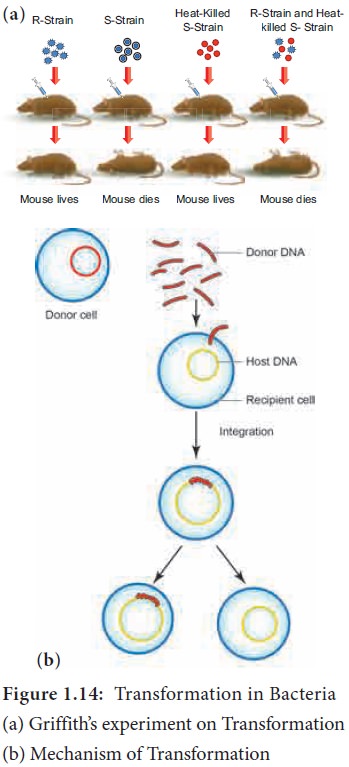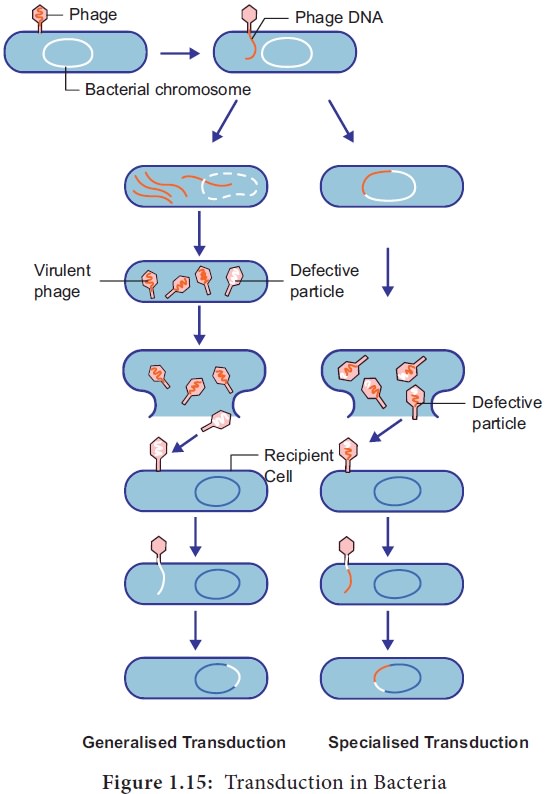Chapter: 11th Botany : Chapter 1 : Living World
Reproduction in Bacteria
Reproduction in Bacteria
Bacteria reproduces asexually by Binary fission,
conidia and endospore formation (Figure 1.12). Among these Binary fission is
the most common one.

Binary fission
Under favourable conditions the cell divides into
two daughter cells. The nuclear material divides first and it is followed by
the formation of a simple median constriction which finally results in the
separation of two cells.
Endospores
During unfavourable condition bacteria produce
endospores. Endospores are produced in Bacillus
megaterium, Bacillus sphaericus and Clostridium tetani. Endospores are thick walled resting spores.
During favourable condition, they germinate and form bacteria.
Sexual Reproduction
Typical sexual reproduction involving the formation
and fusion of gametes is absent in bacteria. However gene recombination can
occur in bacteria by three different methods they are
1. Conjugation
2. Transformation
3. Transduction
1. Conjugation
J. Lederberg and Edward L. Tatum demon-strated
conjugation in E. coli. in the year
1946. In this method of gene transfer the donor cell gets attached to the
recipient cell with the help of pili. The pilus grows in size and forms the
conjugation tube. The plas-mid of donor cell which has the F+ (fer-tility
factor) undergoes replication. Only one strand of DNA is transferred to the
re-cipient cell through conjugation tube. The recipient completes the structure
of double stranded DNA by synthesizing the strand that complements the strand
acquired from the donor (Figure 1.13).

2. Transformation
Transfer of DNA from one bacterium to another is
called transformation (Figure 1.14). In 1928 the bacteriologist Frederick
Griffith demonstrated transformation in Mice using Diplococcus pneumoniae. Two strains of this bacterium are present. One strain produces smooth colonies
and are virulent in nature (S-type). In addition another strain produce rough
colonies and are avirulent (R-type). When S-type of cells were injected into
the mouse, the mouse died. When R-type of cells were injected, the mouse
survived. He injected heat killed S-type cells into the mouse the mouse did not
die. When the mixture of heat killed S-type

cells and R-type cells were injected into the
mouse. The mouse died. The avirulent rough strain of Diplococcus had been transformed into S-type cells. The hereditary
material of heat killed S-type cells had transformed R-type cell into virulent
smooth strains. Thus the phenomenon of changing the character of one strain by
transferring the DNA of another strain into the former is called
Transformation.
3. Transduction
Zinder and Lederberg (1952) discovered Transduction
in Salmonella typhimurum. Phage
mediated DNA transfer is called Transduction (Figure 1.15).

Transduction is of two types
(i) Generalized Transduction (ii) Special-ized or
Restricted Transduction
(i) Generalized Transduction
The ability of a bacteriophage to carry genetic material of any region of bacterial DNA is called Generalised transduction.
![]()
![]()
![]()
(ii) Specialized or Restricted Transduction
The ability of the bacteriophage to carry only a
specific region of the bacterial DNA is called specialized or restricted
transduction.
Related Topics